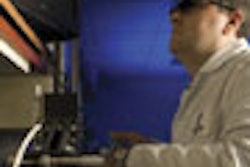Both ultrasound contrast advocates and representatives from the U.S. Food and Drug Administration (FDA) hope the recent advisory committee meeting on the technology will help to advance the development of the field.
"We came away very pleased with the committee, the discussions, and their level of thought as they grappled with this class of agents," said Dr. Karen Weiss, deputy director of the FDA's Office of Oncology Drug Products.
The FDA had called the June 24 meeting of the Cardiovascular and Renal Drugs Advisory Committee in Washington, DC, to provide a public forum for review of the history of currently marketed ultrasound contrast agents, to obtain opinions from the advisors regarding safety considerations in the development of these agents, and to begin to familiarize committee members with the review of diagnostic imaging agents, according to the agency. The meeting was also prompted in part by recent safety considerations for the agents, as well as the development of company risk management plans, the FDA said in premeeting documents.
It came on the heels of a turbulent period for echocardiography contrast regulation in the U.S. The FDA had requested a "black box" warning in October 2007 for the Definity (Lantheus Medical Imaging, North Billerica, MA) and Optison (GE Healthcare, Chalfont St. Giles, U.K.) echocardiography contrast agents after receiving reports of some deaths and serious adverse reactions. The agency later scaled back the warnings earlier this year, following an extensive lobbying campaign from physicians and societies such as the American Society of Echocardiography (ASE).
"The purpose of this advisory meeting was to really get some broader public input on how to develop contrast agents, how to move forward with new agents," Weiss said. "That was the main goal of the meeting, [covering issues such as] what stock to place on animal studies, and how to best identify rare but potentially serious adverse events given some of the constraints of doing controlled trials premarketing."
As part of the meeting, representatives speaking on behalf of ultrasound contrast companies GE, Lantheus, and Bracco of Milan, Italy, gave detailed talks on the strong safety record, clinical utility, and postmarketing surveillance of the Optison, Definity, and SonoVue ultrasound contrast agents.
"[The meeting] was a very good thing for us," said Dr. Steven Feinstein, director of echocardiography at Rush University Medical Center in Chicago; Feinstein spoke on behalf of GE at the meeting. "It allowed us to explore the data that we've all worked on in the last six or eight months, present it to them, and have a very reasoned and thoughtful hearing."
Lantheus representatives also felt they made an effective case for the safety record of Definity.
"At the end of the day, I think we could make a fair summary that there was a very positive benefit-risk balance for the use of Definity across the board and in different patient populations," said Dr. Mark Hibberd, Ph.D., senior medical director of global medical affairs at Lantheus.
The meeting was a good opportunity to present the objective safety data to the committee that will likely adjudicate future safety issues and be involved in the approval of novel imaging agents in the future, said Dr. Michael Main of the Mid America Heart Institute in Kansas City. He also presented data on behalf of Lantheus at the meeting.
Dr. Roxy Senior, director of cardiac research at Northwick Park Hospital in Harrow, Middlesex, U.K., discussed the safety record and clinical utility of SonoVue, which is not yet cleared for use in the U.S.
"The FDA appears to be happy with the safety data provided, but would like us to elucidate the mechanism of the serious events, which in most cases is allergy-like reactions," he wrote in an e-mail to AuntMinnie.com. "The FDA acknowledged that it may be difficult to uncover the mechanism, because it is extremely rare (1:11,000)."
While the goal of the meeting wasn't to focus on the safety of the agents, the presenters did provide a lot of compelling information on safety in their talks, FDA's Weiss said.
"I think they provided some very, very good evidence of their long years [of experience] and large patient databases," she said.
Postapproval trials
While defining the safety of contrast agents can be partially accomplished in the context of randomized trials during their development, it also requires formal, prospective observational trials after approval, said Dr. William Hiatt, chair of the advisory committee and president of the Colorado Prevention Center in Denver.
That suggestion isn't necessarily a radical recommendation, Weiss said. When products potentially provide a very important clinical benefit, the amount of premarketing data will necessarily be somewhat limited because it's difficult to identify rare adverse events.
"That's why we rely heavily on postmarketing, more epidemiological types of studies, observational studies, to try and tease apart events that occur when something is out there and used potentially in somewhat sicker patients or patients with other medications for other uses," she told AuntMinnie.com. "I think their advice is very good, it's something that the group that does the new drug reviews -- our division -- and the group that deals with postmarketing safety, will just need to work closely together on as new products get to market and try to determine how best to design postmarketing, large studies that may not necessarily have a concurrent control group, to try to assess adverse events."
Another strong point of consensus was the need to implement registries of serious adverse events as drugs are approved and monitored, Feinstein said.
"And I think that we all believe that," Feinstein said. "If you start looking back, the reason the FDA was probably forced to act was because they didn't have access to this [type of registry]."
With respect to safety, the committee wanted research to continue to look for patient populations that might be of special risk to adverse events, Hibberd said. It hasn't been possible so far to clearly identify those who may be at greater risk due to the rare nature of these adverse events, he said. And even those rare events are likely to be pseudocomplications, more related to the patient's underlying illness.
"The best way of [looking at this risk] is with large cohorts of data that are accumulated by hospital systems or by multicenter experiences across hospital networks or large outcomes databases that collect data from literally millions of patient experiences, to try and tease out if any of them are at special risk," Lantheus' Hibberd said. "And if they are, then things could be done to make sure that special precautions are taken if those patients still require a contrast echo for any reason."
Effect on outcomes
Another suggestion from the committee pertained to the clinical efficacy of the agents.
"The primary end points of the trials to support the approval of new agents should not just focus on a better image (a 'pretty picture'), but also on how a better image leads to a better clinical outcome," Hiatt told AuntMinnie.com in an e-mail.
That suggestion will require quite a bit more discussion, however, Weiss said.
"Imaging products are very different from therapeutic agents," she said. "We developed guidance a number of years ago on various types of claims that can be made for an imaging agent. In some settings, just looking at the picture, the structure, in and of itself can be a clinical benefit."
For example, many ultrasound contrast users talk about its ability to show a thrombus in the heart cavity, she said.
"I think everybody in the community would agree that if you can see that, and take action to treat that, that would be a clinical benefit," Weiss said.
Moving forward, the results from the committee meeting will help the FDA provide guidance to new ultrasound contrast agent developers on how to design premarketing studies and also how to develop a postmarketing database, she said.
A fair amount of discussion also covered preclinical models, and whether or not the pig, for instance, is a good model to use in development, Weiss said.
"The committee gave us some good advice that the sensitive models [such as the pig] are good, not to take as face value, but as good signal generators," she said.
The FDA foresees an important role in ultrasound contrast for the advisory committee.
"With this sort of introduction to this class of agents and the advice that we've already got, I think it'll be very good to take marketing applications to the committee in the future," she said. "There might be a time, too, where we want to go over with this committee the guidance that was developed on imaging agents and the claims that can be used for imaging-based agents."
While a number of presentations at the meeting dealt with the radiology applications of ultrasound contrast agents, the FDA is not yet ready to formulate opinions about how to develop those new uses, Weiss said.
"We're really not prepared to talk about that at this point," she said.
Ultrasound contrast advocates continue to remain optimistic, however, for the future of the technology. The use of contrast echocardiography is likely to grow, owing to the unique information it provides about the microcirculation, according to Senior.
"And it can be performed at the bedside in real-time unlike other competing technologies," Senior said.
With the FDA's reversal of most of the black box contraindications in May, ultrasound contrast is in a better place right now, Main said.
"Unfortunately, a number of physicians and hospitals still harbor some reservations about using these agents due to the continued presence of the black box warning, which in some people's opinions raises medicolegal issues with respect to use," he said. "That's a bad thing for patients at those hospitals, because they don't have access to the best diagnostic testing available."
"In contrast echocardiography, as we demonstrated at the meeting, we have a technique that's at least 10- to 100-fold safer than alternative imaging procedures, most of which involve radiation exposure or an invasive test," Main continued. "I and my colleagues all feel that the continued presence of the black box warning on these agents is not indicated and is really hurting patients by its negative effect on use."
By Erik L. Ridley
AuntMinnie.com staff writer
July 10, 2008
Related Reading
More study of heart imaging agent risks urged, June 25, 2008
Concerns remain over heart imaging agents: U.S. FDA, June 20, 2008
GE revises Optison's prescribing information, June 11, 2008
ASE welcomes echo contrast labeling change, May 22, 2008
Ultrasound contrast agents appear safe despite FDA warning, April 1, 2008
Ultrasound contrast advocates take aim at FDA black box warning, January 3, 2008
Copyright © 2008 AuntMinnie.com




















